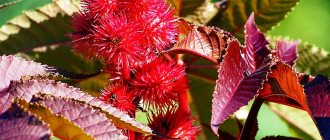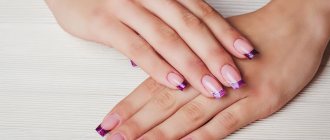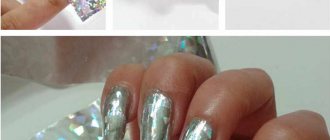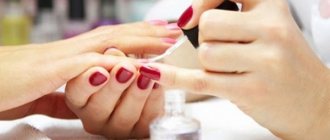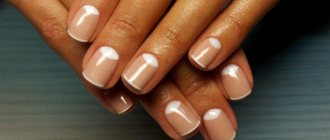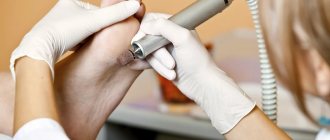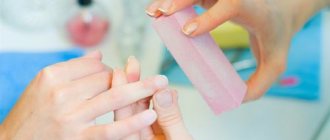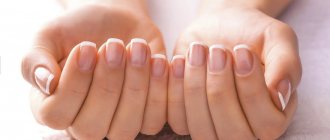Author
: Grachev Ilya Illarionovich
Editor
: Efremov Mikhail Mikhailovich
Date of publication: 06.11.2018 Date of update: 12.11.2020
Nail psoriasis or onychia psoriasis is rarely primary. Typically, this form develops against the background of an existing disease. It affects approximately 10% of psoriasis patients. Interestingly, most often nail lesions accompany psoriatic joint lesions. Another feature is the predominant damage to the nail plates on the hands. Specialists from the Moscow Paramita clinic can effectively treat this disease.
Causes of psoriasis on nails
Nail psoriasis is a chronic skin disease of an autoimmune (allergy to one's own tissues) nature. The disease has not been fully studied; there are many white spots left in it. But it is known for sure that heredity plays a large role in its development: in one family, several people often suffer from this non-contagious dermatosis. In recent years, assumptions about the leading importance of heredity have been confirmed by genetic research, that is, by the presence of special genes.
Psoriasis of any localization can spread throughout the body, so do not delay treatment.
See how easily the disease can be cured in 10-12 sessions.
But not everyone who has a family history gets sick. This also requires exposure to certain general and local factors. General (affecting the entire body) factors contributing to the development of nail psoriasis include:
- any chronic diseases and foci of infection;
- endocrine and allergic diseases;
- eating only high-calorie foods;
- regular drinking, smoking;
- constant emotional tension, stress, hard physical work;
- lack of physical activity, excess body weight;
- violation of the sleep-wake pattern;
- impaired peripheral circulation - with atherosclerosis of the extremities, obliterating endarteritis, etc.;
- anemia – the nutrition of the nail plates is impaired;
- existing psoriasis of any form, especially psoriatic arthritis.
Local factors (of no less importance):
- skin infections, especially fungal ones, affecting the nail plates;
- any mechanical and chemical effects on the nail plates.
When exposed to several causes, metabolism and immunity are disrupted. The body begins to reject its own cells, which leads to the appearance of a psoriatic inflammatory process in the nail area. It is important to notice the problem in time, consult a doctor and begin to treat the disease.
Stages of psoriasis of the nail plate
In its development, nail psoriasis goes through several stages, which have specific symptoms.
- Initial stage. The nail begins to gradually become cloudy. The plate is covered with small stripes, dots, and depressions that resemble a mesh.
- Stage of deformation of the nail plate. There is a thickening of the stratum corneum, a change in its color (gray, brown, yellow), the appearance of blood spots and veins under the nail. Purulent discharge is observed from under the inflamed and thickened cuticle.
- Advanced stage. The nail on the fingers or toes moves significantly away from its bed, the skin around the affected area is inflamed and covered with plaques, the nail fold festers. Everything else can be accompanied by a bacterial or fungal infection.
The signs of nail psoriasis are always pronounced in accordance with the stage of its progression, so a dermatologist can determine the disease by the external condition of the nail and skin around it.
Symptoms of psoriasis on the nails
Nail psoriasis most often develops with existing psoriatic joint damage. Much less often, it complicates the course of cutaneous forms of this disease. To understand how the pathological process spreads on the fingernails and toenails, you need to consider the structure of the nail:
Psoriasis on the fingernails is more common and progresses slowly and unnoticed. The nail plate gradually thickens due to the rapid keratinization of the surface layers. One of the first symptoms of nail psoriasis is the appearance on the nail plates of single white spots or longitudinal lines, as well as pinpoint impressions similar to injections. Gradually, the entire nail becomes covered with such pits (thimble symptom).
When nail psoriasis spreads, the nail matrix (the growth zone responsible for the formation of tissues of the nail plate) is affected, which leads to the melting of the nail tissues - onycholysis. The process begins with the appearance of a yellow-brown border at the free edge of the nail plate. Then the plate is separated from the bed. Its color, thickness, consistency and shape change. Its surface becomes lumpy, grayish-brown or yellow. Further destruction of the plate leads to its atrophy (decrease in volume) or hypertrophy (increase in volume). Often it takes on the appearance of the beak of a bird of prey. The condition may be complicated by severe itching.
When the nail bed (the layer of connective tissue under the nail plate) is damaged, subungual hyperkeratosis develops - thickening of the plate. Under the plate, stains appear that resemble oil stains (oil stain phenomenon).
Single or multiple pinpoint hemorrhages also appear on the nail plates. Instead, brown longitudinal stripes sometimes appear, which also indicates hemorrhage.
Nail psoriasis on the feet is less common. Its manifestations are the same as on the hands. But this form of the disease is sometimes difficult to distinguish from a fungal infection, which has similar manifestations. Sometimes psoriatic lesions on the legs are combined with fungal ones.
Nail psoriasis can be accompanied by inflammation of the skin and periungual tissues around the nail plate - psoriatic paronychia. When an infection occurs, the inflammation of the affected area becomes purulent.
Prevention
At any stage, nail psoriasis on the fingers, as well as psoriasis on the toenails, occurs in waves, with relapses and periodic exacerbations. Therefore, the prevention of psoriasis is important, which includes:
- The need to have as short nails as possible.
- Pedicures, manicures, etc., including acrylic varnish, are prohibited.
- The possibility of microtrauma should be excluded.
- When contacting household chemicals at home, you must use gloves.
Mild cases of the disease require minimal drug therapy. At home, it is recommended to use medicated nail polish, which slows down the destruction of the nail.
It must be remembered that any treatment can be performed after prior consultation with your doctor. This will relieve the acute symptoms of the disease and achieve long-term remission.
How to distinguish nail psoriasis from fungus
- a fungus is an infectious disease that appears after wearing someone else’s shoes, visiting a sauna or swimming pool, etc.; unlike fungal psoriatic process is not contagious;
- the fungus most often affects the toenails, and non-contagious dermatosis on the hands;
- The fungus most often affects the nails of the outer toes (1st and 5th) and the 1st finger of the hand, since they are the ones that are most injured when wearing shoes and in everyday life; the psoriatic process affects all fingernails or toenails; selective damage to the nails makes it possible to distinguish the symptoms of these diseases;
- the appearance of fungal lesions can also be distinguished from psoriatic ones: the fungus causes thickening or deformation of the nail plate, and non-contagious dermatosis causes its detachment from the nail bed;
- if it is not possible to distinguish in the clinic, the presence of an autoimmune process is determined by a blood test and a piece of tissue is taken by biopsy for histological examination - this is the most accurate method, since the appearance of tissues affected by the fungus and the psoriatic process under a microscope is different.
Nail psoriasis: characteristics of the problem and its symptoms (photo)
Nail psoriasis is a rather rare phenomenon, and therefore doctors do not have a clear answer as to why this disease appears. It has been noted that it can occur against the background of an existing psoriatic process that affects the skin or hair. But more often you have to deal only with local damage to the nails.
Photo from the site: psoriaz-ru.ru
Among the factors that provoke the disease are the following:
- Weakened immunity;
- Prolonged stress and tense psychological environment;
- Allergic reactions to external irritants;
- Dysfunction of the peripheral circulation;
- Presence of somatic diseases;
- Heredity.
Symptoms of psoriasis on the fingernails look extremely unsightly. Photos of symptoms:
- One of the first symptoms that should alert a person is the appearance of many depressed points on the nail plate. Normally, several such small dimples are acceptable. With psoriasis, the nails seem to be wounded by numerous holes, and resemble a sheet of iron beaten by hail or a thimble. By the way, this symptom is called the “thimble” symptom.
Photo from the site: dermalight.su
- The appearance of longitudinal grooves on the nails. They have a whitish color and a characteristic ribbed outline, reminiscent of a washboard.
Photo from the site: dermalight.su
- Often, psoriatic plaques and papules appear around the skin affected by nail psoriasis. The skin is inflamed and has a characteristic red color.
Photo from the site: dermalight.su
- Formation of yellow or red spots under the nails. As a rule, they are localized in the central part of the nail plate. You can also notice red or blue streaks - these are hematomas formed due to damage to blood vessels.
Photo from the site: dermalight.su
- Psoriasis is often accompanied by onycholysis. This is a phenomenon in which the nail plate partially moves away from the nail bed. In the initial stages of the lesion, detachment occurs only in the area of the free edge of the nail, penetrating further and further. At the same time, the nail rises into a springboard-like position. If you do not take measures to treat psoriasis, your nails can be completely lost.
Photo from the site: dermalight.su
- Another symptom is loosening of the nail. Nails become dry and crumble.
Photo from the site: dermalight.su
- Change in color of the nail plate. It can take on any color from whitish to brown.
Photo from the site: dermalight.su
Most often, psoriasis affects women (in 80% of all identified cases). It has also been noted that psoriasis of the hands is always accompanied by psoriasis of the toenails (photo)
Photo from the site: mazotpsoriaza.ru
Stages of nail psoriasis
Nail psoriasis occurs slowly and is initially unnoticeable. Just as with other forms, the course is divided into the following three stages:
- initial or progressive - all symptoms slowly increase; timely treatment of nail psoriasis stops the progression and moves the course to the next stage;
- stationary - this stage can be determined by the fact that the disease does not progress, but does not decrease; this stage can last a long time;
- regressive – symptoms gradually disappear; With proper treatment, the appearance of the limb is restored.
Red spots on the skin after stress
Diagnosis of skin diseases
Your nails will be beautiful and healthy
“PsorMak” is a clinic for the treatment of nail psoriasis with many years of experience in successful therapy. After treatment with us, patients note long periods of remission and significant improvement in the nail plate.
Why you should contact PsorMak Institute:
- Effective treatment. Provided you carefully follow all medical recommendations, you can achieve stable remission of psoriasis for a period of six months to six years.
- More than 20 years of experience in treating skin diseases. Thanks to the original methods of Academician V. F. Mak, hundreds of patients were successfully cured of many dermatological diseases.
- No need to go to hospital. All therapeutic regimens of the Institute of Healthy Skin are designed for outpatient use, which allows patients to maintain a normal rhythm of life during treatment.
- Affordable price. Thanks to an affordable pricing policy, the PsorMak clinic treats patients with a wide variety of budgets.
- Safe methods of therapy. Treatment of skin diseases at the PsorMak clinic is carried out without the use of “heavy” hormonal drugs and other medications that can harm the health of patients.
- Individual approach. Our doctors select the most effective therapeutic regimen for each patient, taking into account his age, duration of the disease and characteristics of the body.
Our specialists will accompany you at all stages of treatment, help you overcome the disease and restore the attractive appearance of your nails. You can make an appointment by phone or through the online form.
Treatment methods for psoriasis on the nails
There is no question about how to cure nail psoriasis. This is a chronic disease that cannot be completely cured. But preventing a relapse is quite possible. For treatment of nail psoriasis to be effective, it must be comprehensive and systematic. It should include:
- lifestyle changes;
- diet;
- medicinal (drug) therapy;
- modern methods of non-drug treatment;
- traditional oriental methods of treatment;
- folk remedies.
What medications will help eliminate relapse?
Drug treatment of nail psoriasis is a rather complex task, requiring an individual doctor’s approach to each patient. The doctor decides how to treat nail psoriasis after an examination, taking into account the form of the disease, the presence or absence of lesions of other organs and systems, as well as concomitant diseases. Locally prescribed:
- Dithranol, Cygnoderm, Anthralin
- ointments and creams that suppress proliferation (too rapid reproduction) of cells formed in the matrix; the drugs are toxic and can irritate healthy skin in the nail area; - corticosteroid ointments, creams and solutions
- betamethasone (Akriderm, Celestoderm), prednisolone, etc.; suppress inflammation, itching and proliferation; - salicylic ointment 1%
- removes dead cells, has antibacterial and antifungal effects; - 70% solution of Cyclosporine
- treatment of affected nail plates to suppress immune activity; - tar preparations
– has a cleansing and restorative effect; - ointments and creams with a synthetic analogue of vitamin D,
calcipotriol (Davonex, Psorkutan); - combined products
- ointments, creams and solutions, which include antipsoriatic drugs from different groups.
Taking drugs of general (systemic) action is prescribed for severe lesions of the nails, which are accompanied by inflammation, itching and pain.
Modern methods of non-drug treatment of nail psoriasis
There are many modern non-drug methods for treating psoriatic processes. The most effective are:
- PRP – therapy; relatively recently it was found that platelets (blood platelets) take an active part in tissue repair; the method consists of injecting the patient’s platelet-rich blood taken from his vein into the affected areas of the nail plates; All patients noted a positive effect from the course of treatment; Even advanced cases of nail psoriasis are treated;
- autohemotherapy - intramuscular injection of the patient’s blood taken from a vein; the method is not new, but continues to be used, as it helps to cure and prevent relapses;
- herbal medicine - modern drug treatment regimens usually include specially selected herbal remedies that can potentiate (strengthen) the effect of drugs; this helps reduce the drug burden on the patient's body.
Traditional oriental treatments
In the East, China and Tibet, stable remission is achieved with the help of reflexology (RT) - by influencing active acupuncture points (AP), reflexively associated with various organs and tissues.
Doctors in Ancient China understood that it was impossible to cure nail psoriasis, but its relapses were successfully cured. Therefore, much attention was paid not only to treatment, but also to the prevention of exacerbations. In their practice, they used various RT techniques - acupuncture (acupuncture), moxibustion with wormwood cigarettes, exposure of the AT to vacuum (vacuum therapy), acupressure, including AT on the auricle, etc. The results of this treatment are impressive.
All these techniques are successfully used today. But you should know that high-quality training in reflexology can only be obtained in Chinese or Tibetan clinics. In the hands of a real master, the RT method can cure a relapse of nail psoriasis without the use of drugs. Anti-relapse courses of RT allow patients to forget about exacerbations for a long time.
Treatment of nail psoriasis using folk methods
Good to know
- Treatment of psoriasis on the head
- Treatment of psoriasis on the elbows
- Treatment of psoriasis on the legs
- Treatment of psoriasis on the hands
- Treatment of psoriasis on the face
- Treatment of palmoplantar psoriasis
For nail psoriasis, folk remedies are also used. But you cannot use them without consulting a dermatologist. The psoriatic process is insidious - the slightest violation of the rules of treatment can accelerate its progression. Properly prescribed folk remedies do not produce side effects; they can be used both as part of complex treatment and independently (for mild cases). The following folk remedies will help cure relapse at home:
- compresses (applications) from a decoction of bay leaves
; the decoction is prepared at the rate of 15 -20 leaves per liter of water; it should be kept in a water bath for half an hour; after filtering, the broth is cooled and used for compresses; suitable for inflammation of periungual tissues, as it has an antiseptic and anti-inflammatory effect; - salidol ointment
; mix equal parts of medical salidol (buy at a pharmacy) and petroleum jelly; after obtaining a homogeneous mass, apply to affected nails 2 – 3 times a day for three weeks; promotes rapid cleansing and prevents the development of complications.
Nail psoriasis: treatment and photos
Treatment of fingernail psoriasis will require a long time and strict adherence to the rules. The course of complete recovery can take up to six months. In this case, you should always strictly adhere to generally accepted rules of hygiene:
- Nails affected by psoriasis should be trimmed short. Women will have to forget about manicure for a long time. Painting nails is strictly prohibited. Cuticle cutting is strictly prohibited.
- It is necessary to protect your nails during any household work. Wear gloves, even when preparing food.
- Try to avoid injuries to your nails and fingers; give up bad habits that lead to nail injuries.
- Carry out hygiene procedures regularly, moisturize your skin and nails with cream.
- Use medical clear varnish to protect your nails.
Let's look at how to treat psoriasis of the fingernails.
Psoriasis of fingernails: drug treatment
Photo from website: senao.org
Medical measures for the treatment of nail psoriasis and what drugs should be prescribed to the patient will completely depend on the form of the disease, the degree of damage and the course of the disease. So, patients with psoriasis can be prescribed the following recommendations:
- Treatment of affected nails with Calcitopril (an analogue of vitamin D), and the skin around them with a solution of retinol (vitamin A).
- Taking Methotrexate, an analogue of folic acid (vitamin B9).
- Phototherapy (insolation) and vitamin D3 are recommended. They help slow down cell growth and improve the external condition of the skin.
- Taking immunostimulating drugs.
- In especially severe cases, hormonal therapy is prescribed. They are quite effective in treating psoriasis, but there is a risk of addiction.
- To slow down cell growth, vitamin D3 is used, as well as UV radiation (phototherapy).
In addition to medicinal effects, diet is important for nail psoriasis. Patients are advised to refrain from unlimited consumption of sweet, spicy and smoked foods. Salty and fatty foods are prohibited. Thermal treatment of foods by steaming or baking is preferable; fried foods are contraindicated. Also on the list of prohibited foods are eggs, milk, nuts, nightshades, carbonated and alcoholic drinks.
The diet should be rich in fresh vegetables and fruits, herbs, fish, and lean meat. You should strictly observe the water consumption regime - at least 2 liters per day (and this is only clean water, excluding liquids supplied with food).
Treatment of nail psoriasis at the Paramita Clinic
Patients with nail psoriasis in our clinic in Moscow are treated not only for relapses of the disease, but also constantly receive supportive anti-relapse courses of treatment, which allows them to forget about the unpleasant sensations for many years. The Paramita Clinic gives its patients a feeling of security, because they can contact it at any time.
Over the years of medical practice (we have been working since 2008), our doctors have developed unique methods for treating psoriatic processes, which include the most effective techniques of Eastern and Western medicine. At the moment, we are the only clinic that can guarantee the elimination of all symptoms of psoriasis on the nails and stable remission with a complete absence of side effects.
To avoid relapses, it is necessary to eliminate the cause of the disease.
Read more about our unique method of treating psoriasis
Distinctive features of the clinic are:
- comfortable conditions for visiting a doctor;
- individual approach to each patient;
- multilaterally trained experienced specialists; all doctors have basic training in dermatology and have been trained in certain modern and oriental methods of treatment; All specialists studied Eastern methods in China and Tibet;
- treatment of the patient until the symptoms of the disease are completely eliminated, followed by systematic anti-relapse courses.
Sign up for a free initial appointment
Treatment methods at home
It is necessary to combat nail psoriasis comprehensively, using not only combined traditional medicines, but also folk remedies.
Drug treatment of nail psoriasis
Therapy for psoriatic onychodystrophy begins with local medications. These can be ointments, lotions, sprays, creams. The most effective are:
- anthralin;
- tazorine;
- betamethasone;
- calcipotriene.
The initial stages respond well to treatment with special varnishes (Belvedere), which slow down or stop the development of onychodystrophy. In addition, it is recommended to treat the periungual phalanges with moisturizing gels.
Belvedere polish will help improve your nails
It is recommended to supplement external medications with vitamins and immunomodulators (Imunoflazid, Tiluron).
If the effect of local medications is weak, doctors prescribe systemic medications (injections, tablets). Methotrexate, Acitretin, Cyclosporine help relieve symptoms and improve the condition of nails.
Treatment can take place at home, but it is prescribed exclusively by a doctor, since many drugs have contraindications and can harm a person’s health.
Therapy with folk remedies
What to do if traditional medicine does not produce the desired effect or improvement occurs too slowly? In this case, you can resort to traditional medicine. There are many good recipes that will help enhance the therapeutic effect of pharmaceutical drugs and achieve remission.
- Therapeutic baths. To prepare, you need 30 g of bay leaves and 2 liters of boiling water. Place the herb in hot water and simmer over low heat for 5-10 minutes, then let cool to 37-40 degrees. Place your hands (feet) in the prepared broth for 15–20 minutes. Water procedures can be done daily for 1-2 months.
- Soda compresses. Dilute 2 tsp in a glass of warm water. soda Soak a cotton pad in the solution and apply to the affected nails for 15–20 minutes. The course of treatment is 10–12 sessions (every other day).
- Healing lotions. Mix corn and oatmeal (1 tablespoon each) in 0.5 liters of warm water. Apply a homogeneous paste to the injured areas for half an hour. Therapy continues until improvements are visible.
Lotions with corn flour will improve the condition of your nails
After the procedures, the nails must be carefully processed to allow the medicinal substances to penetrate deeper into the affected plates. To do this, you can use a nail biter (tweezers) and a nail file.
Also on the topic: Symptoms and treatment of psoriatic arthritis
With the help of folk remedies, it is possible to forget for a long time not only about onychodystrophy, but also about psoriasis in general. The main thing is to consult your doctor before starting alternative treatment.
Lifestyle and nutrition for nail psoriasis
Lifestyle and nutrition are of great importance in the treatment of nail psoriasis, since the basis of this disease is a metabolic disorder. With a sedentary lifestyle, the metabolism slows down, which affects the immune system and causes a chain reaction of the development of the programmed psoriatic process. But heavy physical activity is contraindicated for people in the severe group for this disease. Only a measured lifestyle with light sports, sufficient time in the fresh air and a regulated sleep-rest regime will help.
The daily diet determines the intake of nutrients into the body, from which energy is then obtained and a person’s own tissues are built. The mechanism of development of the disease is also associated with an autoimmune process - an allergy to the patient’s own tissues. Therefore, food allergies will intensify all manifestations of the disease.
There is no special diet for this disease. But it was noticed that relapses often occur when eating high-calorie foods high in animal proteins, fats and easily digestible carbohydrates. Therefore, patients should adhere to certain dietary rules, giving preference to plant-based foods rich in vitamins. Do not use:
- alcohol, caffeinated drinks;
- spicy seasonings;
- sweets and baked goods;
- vegetables from the nightshade family: tomatoes, peppers, eggplants;
- fatty animal products.
You can use it, but not every day:
- lean meat, fish, dairy products;
- sour fruits and berries;
It is recommended to use without restrictions:
- any vegetables, except those prohibited, in raw, boiled and stewed form;
- any fruits, except sour ones;
- self-squeezed juices (no preservatives);
- drinking water.
Nail care for psoriasis
Nail psoriasis is a chronic disease that can recur for any reason that provokes its appearance : stress, illness, nutritional disorders. If you have an illness, you should follow the recommendations of doctors to curb the manifestation of the disease: When coming into contact with household chemicals, do not forget to protect your hands with gloves, since exposure to the products can trigger a relapse of the disease. The substances included in the composition destroy the natural structure of the nail plate, weakening it, which will help lead to the appearance of the first signs of the disease. Try to avoid injuries to the nail plate : even a minor splinter can lead to the formation of an infectious nest. Maintain good hand hygiene.
If nail psoriasis has already manifested itself, it is not recommended to do cosmetic procedures on the nails . Extensions and gel coating are strictly prohibited, since on a closed nail plate the development of the disease will not be immediately noticed, which can lead to complications. The use of even decorative varnish is not recommended.
It is better to cut nails affected by psoriasis short: the appearance of the diseased nail is far from aesthetically pleasing; sick long nails contribute to the development of the disease. It is better to cut off the affected areas. Don't ignore nail psoriasis! Be sure to treat!
Prevention of nail psoriasis
To prevent relapses, you must constantly adhere to certain rules that exclude exposure to risk factors on the body:
- lead a healthy lifestyle, eat right;
- promptly treat all diseases, eliminate foci of infection;
- avoid high emotional and physical stress;
- do not drink alcohol, do not smoke;
- touch any chemicals or skin irritants only with gloves;
- do not irritate the nail plates with manicure; It is advisable to coat them with a protective varnish;
- regularly apply a rich cream to the nail plates, and a cream with vitamin A to the growth area.
It is not possible to get rid of nail psoriasis forever, since the patient is constantly faced with some risk factors. But it is quite possible to ensure that these factors do not have a negative impact: you just need to follow the recommendations of your doctor and regularly carry out anti-relapse treatment.

